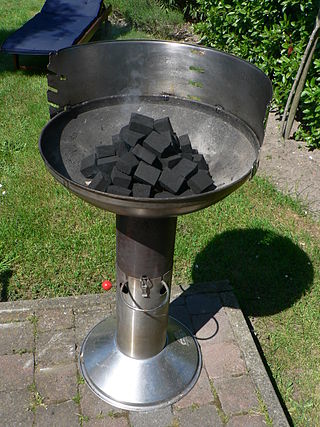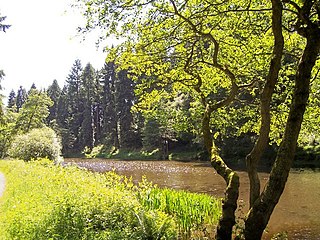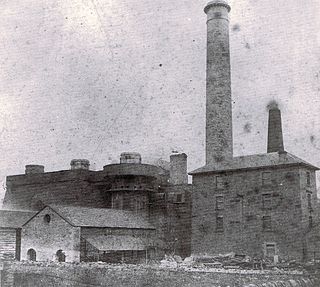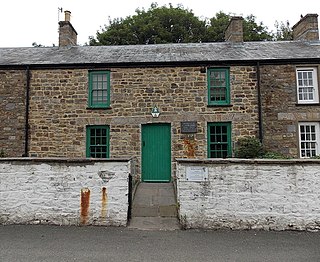
The Forest of Dean is a geographical, historical and cultural region in the western part of the county of Gloucestershire, England. It forms a roughly triangular plateau bounded by the River Wye to the west and northwest, Herefordshire to the north, the River Severn to the south, and the City of Gloucester to the east.

Parkend is a village, located at the foot of the Cannop Valley, in the Royal Forest of Dean, West Gloucestershire, England, and has a history dating back to the early 17th century. During the 19th century it was a busy industrial village with several coal mines, an ironworks, stoneworks, timber-yard and a tinplate works, but by the early 20th century most had succumbed to a loss of markets and the general industrial decline. In more recent times, the village has become a tourist destination.

The River Eden is a tributary of the River Medway in south east England. It rises at the foot of the North Downs escarpment near Titsey in Surrey and runs initially southwards through Oxted before turning eastwards to enter Kent. After flowing through Edenbridge and passing Hever Castle, the Eden meets the Medway at Penshurst.

A royal forest, occasionally known as a kingswood, is an area of land with different definitions in England, Wales, Scotland and Ireland. The term forest in the ordinary modern understanding refers to an area of wooded land; however, the original medieval sense was closer to the modern idea of a "preserve" – i.e. land legally set aside for specific purposes such as royal hunting – with less emphasis on its composition. There are also differing and contextual interpretations in Continental Europe derived from the Carolingian and Merovingian legal systems.

Alfold is a village and civil parish in Surrey, England on the West Sussex border. Alfold is a dispersed or polyfocal village in the Green Belt, which is buffered from all other settlements. The Greensand Way runs north of the village along the Greensand Ridge and two named localities exist to the north and south of the historic village centre which features pubs, a set of stocks and a whipping post.

Wychwood or Wychwood Forest is a 501.7-hectare (1,240-acre) biological Site of Special Scientific Interest north of Witney in Oxfordshire. It is also a Nature Conservation Review site, Grade 1, and an area of 263.4 hectares is a national nature reserve The site contains a long barrow dating to the Neolithic period, which is a scheduled monument.

Barbecue varies by the type of meat, sauce, rub, or other flavorings used, the point in barbecuing at which they are added, the role smoke plays, the equipment and fuel used, cooking temperature, and cooking time.

The Weald and Downland Living Museum is an open-air museum in Singleton, West Sussex. The museum is a registered charity.

Dalgarven Mill is near Kilwinning, in the Garnock Valley, North Ayrshire, Scotland and it is home to the Museum of Ayrshire Country Life and Costume. The watermill has been completely restored over a number of years and is run by the independent Dalgarven Mill Trust.

Soudley is a small village to the west of Cinderford, in the Forest of Dean, west Gloucestershire, England. It joins with Ruspidge to form a civil parish.

Northchapel is a village and civil parish in Chichester District in West Sussex, England. It stands on the A283 road just south of the Surrey border, around 9 km north of Petworth.

Clearwell is a village and former ancient manor in the Forest of Dean, West Gloucestershire, England. A recent survey indicated that the population of Clearwell is approximately 350.

Lying close to the village of Soudley in the Forest of Dean, west Gloucestershire, Soudley Ponds, also known as Sutton Ponds, comprise four linked man-made ponds lined in succession through the narrow Sutton Valley, and surrounded by stands of tall Douglas Fir. It is a 7.04-hectare (17.4-acre) biological Site of Special Scientific Interest notified in 1984.
The Bullo Pill Railway was an early British railway, completed in 1810 to carry coal mined in the Forest of Dean Coalfield to a port on the River Severn near Newnham, Gloucestershire. It was later converted to a broad gauge steam line by the Great Western Railway, and was closed in the 1960s.

Charcoal is a lightweight black carbon residue produced by strongly heating wood in minimal oxygen to remove all water and volatile constituents. In the traditional version of this pyrolysis process, called charcoal burning, often by forming a charcoal kiln, the heat is supplied by burning part of the starting material itself, with a limited supply of oxygen. The material can also be heated in a closed retort. Modern "charcoal" briquettes used for outdoor cooking may contain many other additives, e.g. coal.

Ifield Water Mill is a 19th-century weatherboarded watermill in the Ifield neighbourhood of Crawley, a town and borough in West Sussex, England. Built on the site of an earlier, smaller flour mill, which itself replaced an iron forge—one of many in the Crawley area—it fell into disuse in the 1930s. The local council, which acquired the land for housing development in the 1970s, leased the mill to local enthusiasts, who restored it to working order. The mill and an associated house are listed buildings, and there is also a cottage on the site.

Whitecliff Ironworks, sometimes referred to as Whitecliff Furnace, at Coleford, in the Forest of Dean, Gloucestershire, England, are industrial remains associated with the production of iron, using coke, in the Forest of Dean.

Parkend Ironworks, also known as Parkend Furnace, in the village of Parkend, in the Forest of Dean, Gloucestershire, England, was a coke-fired furnace built in 1799. Most of the works were demolished between 1890 and 1908, but the engine house survived and is arguably the best preserved example of its kind to be found in the United Kingdom.

Joseph Parry's Cottage, also known as 4 Chapel Row, is a cottage located in Merthyr Tydfil, in South Wales. Built in the early 19th century for ironworkers, the cottage is best known as the birthplace of the famous Welsh composer Joseph Parry (1841–1903). It is now open to the public as a museum.

Schwerkolt Cottage is a pioneer cottage built around 1880 at Mitcham, Victoria.






















